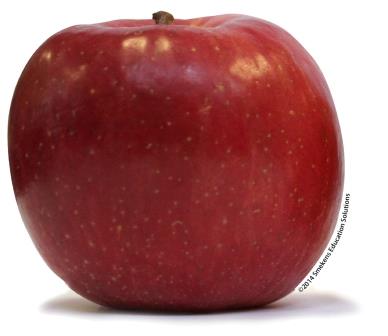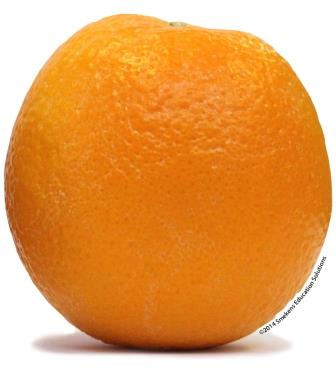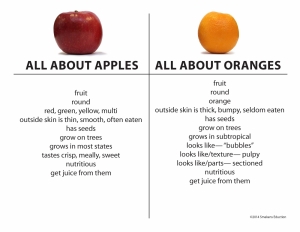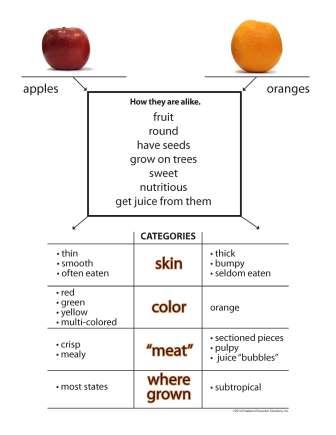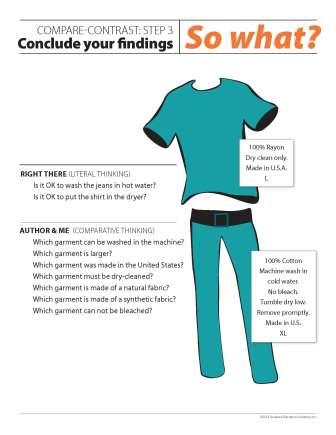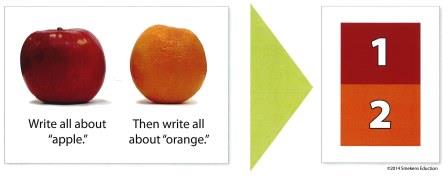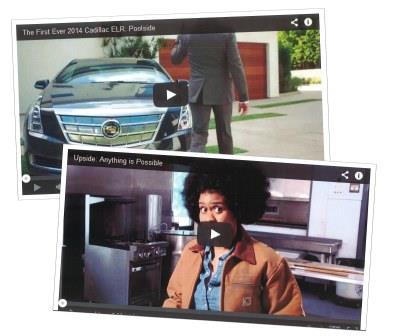Literacy Retreat 2014
SECRET SITE
Cultivating Compare-Contrast Skills
Comparing Apples & Oranges
Introduce the various phases of comparative thinking using apples and oranges to represent Item A and Item B. Access JPEG images of each combination.
Phase 1: Description
- Download a list of comparative concepts broken by grade range and content area.
- Access a simple 2-column chart that can be projected during a whole-class lesson or printed and laminated for individual student “white boards.”
- When describing two concrete objects, students can look for similarities and differences based on the descriptive attributes list.
- Build a matrix/semantic map of information about a variety of topics using the jigsaw-reading strategy.
- Describe apples and oranges in two separate lists using a 2-column chart.
Phase 2: Compare similarities & differences
- K-1 teachers will love these sorting activities. This is a necessary skill to teach; before students can compare, they have to be able to sort.
- Sort details from two separate lists into similar and different lists. (Here’s an example with apples and oranges.)
- Reveal comparative features using these graphic organizers. (Here’s an example with apples and oranges.)
- Mine for connections using the Y-Charts.
- Through a List, Sort, & Label activity, students can hone their abilities to identify common features. (Notebook version available).
- For high-ability and GT students, make the sorting activities more challenging by having partners play “Guess the Sort.” (Details explained within the PPT.)
- When identifying “common denominators” between the compared items, remember to choose broad categories or features. (If it’s too narrow of a facet, then the piece becomes very listy.) Here is an example for comparing two characters or the movie version to the original book. Then have students attempt to generate their own broad categories when comparing Fall v. Spring and Recess v. P.E.
Phase 3: Conclude (& support) your findings
- Make a value judgment and answer the so what?
- Relate this judgment or decision to the thinking process necessary in solving many math problems. After comparing the information between items, the consumer has to make judgments or decisions about what is the best value.
- Start with simple sentence starters.
- Download examples of authentic compare-contrast conclusions from students that make a value judgment and support it.
Display comparative thinking in 1 of 3 ways
1. When you separate topics completely, you write all about Item A and then all about Item B. None of their details intermingle. This is the most simplistic approach because writers don’t have to use transitions to juggle multiple sets of details.2. A more advanced approach to compare-contrast writing is to write about both items and how they are similar. This might include several points of comparison. Then, the next portion of the piece includes details unique to one item. When those are complete, then write about the details unique to the other item. (NOTE: You could also flip-flop this approach, starting with their differences and ending with their similarities.)
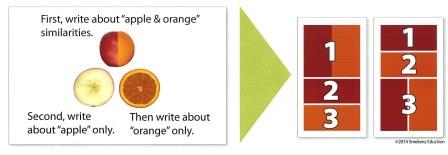
3. The most sophisticated approach is a tit-for-tat organization. This piece is centered around comparative qualities or categories. For each quality introduced, the writer addresses how it pertains to both items. If it is similar, then that’s how the paragraph reads. If it’s contrasting, then those unique differences are explained. Although juggling lots of information, the writer needs to create a smooth flow of ideas using appropriate transitions.
Download the mini-posters that depict the 3 ways to organize a compare-contrast piece.
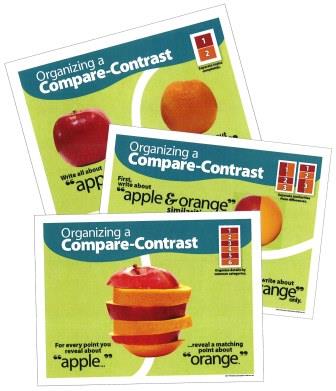
Sample assignments
A great website for topic comparisons of various hot topics is The Difference Between.
Compare Miss Nelson to Miss Swamp in Miss Nelson is Missing.
Compare different perspectives of the same story, including:
- The Three Little Pigs v. The True Story of the Three Little Pigs!
- Goldilocks and the Three Bears v. Deep in the Forest
Compare versions of the same story from different cultures, including:
- Cinderella v. The Rough-Faced Girl
- Little Red Riding Hood v. Lon Po Po
Compare similar plots/themes, including:
- The Emperor’s New Clothes v. The Principal’s New Clothes
- Chicken Little v. Henny Penny
Compare texts by the same author, including:
- The Hat v. The Mitten, both by Jan Brett
Compare The Lion King (animated Disney movie) v. The Lion King (Descriptive Video version):
- Students watch the opening scene of the standard version of the Disney film The Lion King and write a description of it. They then watch the same opening scene with the descriptions and captions available online from the National Center for Accessible Media. They will write another descriptive summary on this scene. Students share their two writing samples aloud and compare their pre- and post-audio descriptions.
Compare perspectives between the Cadillac commercial v. Ford commercial:
- Show each commercial individually. Ask students to take specific notes on what they hear, see, and feel as they view each one. Then ask students to identify some common features to compare. During the conclusion step, students determine which commercial is a stronger marketing campaign. (NOTE: There are numerous online articles and comments about the two commercials that could fuel a strong class discussion about perspective and author’s purpose.)
More Mentor Texts & Favorite Resources
Professional Resources
- Compare & Contrast: Teaching Comparative Thinking to Strengthen Student Learning, Harvey F. Silver
- Context Clues & Figurative Language: Grades 4-8, Linda Ward Beech
- Crafting Comparison Papers, Marcia S. Freeman
- Reading Passages That Build Comprehension: Compare & Contrast: Grades 2-3, Linda Ward Beech
- Teaching Students to Write Comparison/Contrast Essays, Peter Smagorinsky, Larry Johannessen, Elizabeth Kahn, Thomas McCann
Picture Books
Past & Present
- Now & Ben: The Modern Inventions of Benjamin Franklin, Gene Barretta
- Those Rebels, John & Tom, Barbara Kerley
Comparing Past and Present Series, Rebecca Rissman
- Cleaning Up
- Cooking and Eating
- Going to the Doctor
- Going to School
- Playing with Friends
- Taking a Trip
Animal v. Animal
- Polar Bears and Penguins, Katharine Hall
- Animals Head to Head series, Isabel Thomas
- Alligator vs. Crocodile
- Lion vs. Tiger
- Shark vs. Killer Whale
- Which Animal is Which? series M. Stewart
- Alligator or Crocodile?
- Butterfly or Moth?
- Frog or Toad?
- Insect or Spider?
- Salamander or Lizard?
- Shark or Dolphin?

